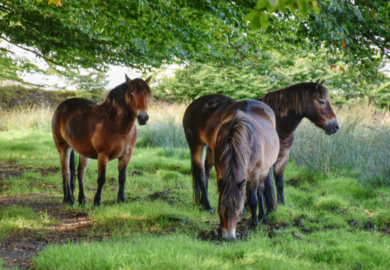Porlock Weir wasn’t on the itinerary when we set out.
Our walk that morning had begun high above the coast in Exmoor’s Horner Wood. Shafts of sunshine penetrated the dense canopy, creating puddles of light on the forest floor as we made our way through the ancient oak trees.
Joining The Coleridge Way, we gradually descended to the village of Porlock. Separated from its natural harbour when the sea receded some time before the 11th-century, the village now stands a mile inland. Looking at the map, we decided to continue our route all the way to the original western edge of the village which still stands on the coast and is known as Porlock Weir.
Strolling past thatched cottages whose whitewashed walls blinded with the reflected sunlight, the tables and benches of the Ship Inn bustled with day visitors and dog walkers enjoying the unseasonal warmth. Following the curve of the harbour past Porlock Weir Hotel, we crossed over the dock-gate bridge to so-called Turkey Island and strolled to the harbour wall. A row of three thatched cottages stood at right angles to the harbour looking out over the hulls of small boats randomly stranded in the silt, waiting for the tide to return. The pastel frontages of the cottages cried out to be photographed. Jack duly obliged as, no doubt, thousands of others do every year.
Porlock Weir was documented in the Anglo-Saxon Chronicle over a thousand years ago, its natural harbour providing one of few safe moorings for craft. It derives its name from the weirs – rows of stakes driven into the beach – which caught salmon at high tide. A vital part of the life of eastern Exmoor, the port was the hub of imports and exports, both legal and smuggled, throughout the 17th-19th centuries. A thriving smuggling trade saw tobacco, tea, sugar, and barrels of wine landed without any duty being paid. The main exports included local butter, cheese, bacon, pork and apples, along with pit props for Welsh mines, and oysters.
Porlock Bay oysters
The oyster trade began in the 1830s when an oyster man, returning from the Mumbles in the Gower Peninsular, dropped his dredge in Porlock Bay just to see if he could get anything. It came up full of oysters. Within 20 years the oyster business had grown into a significant local industry alongside herring and line fishing. Wooden stake holding pens, or ‘weirs’, known as ‘perches’ were built to hold the oysters before being sent to market. One of the perches is still visible at low tide. Trade flourished, boosted further by the opening of the railway at Minehead in 1874, giving fast access to London. It was said that oysters caught in Porlock Weir in the morning were being served in top London restaurants the same evening.
In the 1890s the oyster beds were stripped clean by neighbouring dredgers and the trade was destroyed. Happily, two members of Porlock Parish Council decided to try to reinstate the trade in 2013 to provide a cottage industry for the Porlock Bay community. Their trials were a resounding success, resulting in Porlock Bay Oysters being the first site in England and Wales to attain an A Classification from the Foods Standards Agency for Pacific oysters. As oysters are only dredged in months without an ‘r’ in them, we are poised for May to arrive so we can head back to Porlock Weir and try these prized specimens.





